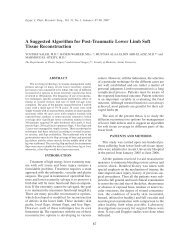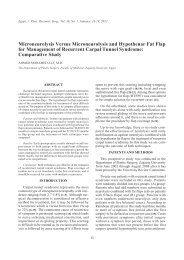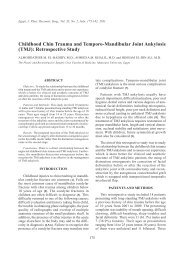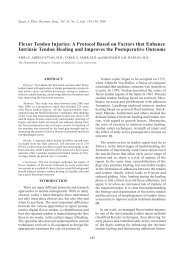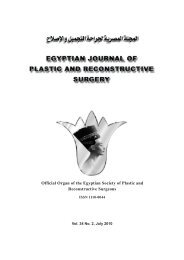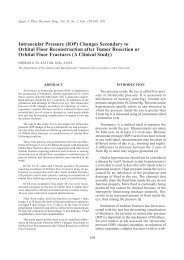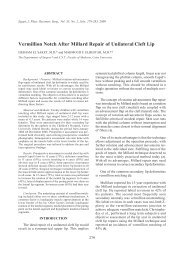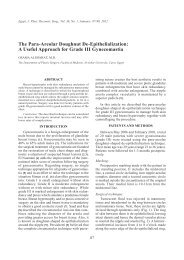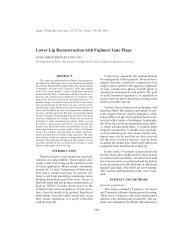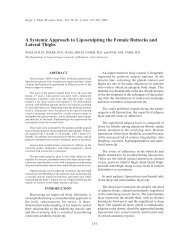Cranioplasty: Successful Use of Rib Grafts - ESPRS
Cranioplasty: Successful Use of Rib Grafts - ESPRS
Cranioplasty: Successful Use of Rib Grafts - ESPRS
You also want an ePaper? Increase the reach of your titles
YUMPU automatically turns print PDFs into web optimized ePapers that Google loves.
Egypt, J. Plast. Reconstr. Surg., Vol. 32, No. 1, January: 13-22, 2008<br />
<strong>Cranioplasty</strong>: <strong>Successful</strong> <strong>Use</strong> <strong>of</strong> <strong>Rib</strong> <strong>Grafts</strong><br />
AHMED MAHROUS, M.D.*; ABDOU DARWISH, M.D.* and HOSNY SALAMA, M.D.**<br />
The Departments <strong>of</strong> Plastic Surgery Unit*, General Surgery and Neurosurgery Unit**, General Surgery,<br />
Faculty <strong>of</strong> Medicine, El-Minia University.<br />
ABSTRACT<br />
Background: Numerous materials are available for use in<br />
cranioplasty including bone, ceramics and metals. <strong>Rib</strong> graft<br />
as a construct for cranial reconstruction <strong>of</strong>fers several advantages<br />
including autologous bone source, a formable plateform,<br />
low infection rate, regeneration at the donor site and high<br />
fusion rates.<br />
Aim <strong>of</strong> the Work: The present series aims to clinical<br />
evaluation <strong>of</strong> the use <strong>of</strong> rib grafts in cranioplasty.<br />
Patients and Methods: <strong>Rib</strong> autograft cranioplasty was<br />
performed in 15 patients. 12 <strong>of</strong> them were males and 3 were<br />
females. The mean age was 18 years. When single rib needed,it<br />
has been harvested from the 5 th rib and when two ribs needed,<br />
they were harvested from the 4 th and 6 th ribs. 20 ribs were<br />
totally harvested.<br />
Results: The reasons for cranial reconstruction were: Post<br />
traumatic calvarial defects (73,6%). Previous craniotomy<br />
(13,2%), congenital defect (6.6%) and fibrous dysplasia<br />
resection (6.6%). The size <strong>of</strong> the defects ranged between 15<br />
and 84cm 2 . The mean follow up period was 16 months postoperatively.<br />
Normal cranial contour was achieved in all<br />
patients. One patient developed CSF leak that resolved spontaneously.<br />
No donor site complications were noted (Pneumothorax,<br />
haemothorax, post-operative pain), no post-operative<br />
infections were encountered and graft resorption was not<br />
noticed in all patients.<br />
Conclusion: The use <strong>of</strong> autologous rib graft for cranioplasty,<br />
particularly in young age group, was found to have<br />
low cost effectiveness, easily harvested, easily moulded to<br />
the skull shape, osteointegrated adequatly with the surrounding<br />
bone thus <strong>of</strong>fers good brain protection and is associated with<br />
low complication rate.<br />
INTRODUCTION<br />
The primary justification for craniopasty procedures<br />
are to re-establish protection for the underlying<br />
cerebral and vascular structures and to<br />
provide an acceptable cranial contour so that the<br />
cosmetic result is aesthetically pleasing. Numerous<br />
materials are available including bone, ceramics<br />
and metals [1]. In situations in which autogenous<br />
bone is lacking or unsuitable, alloplastic compounds<br />
may be used. Numerous materials have been used<br />
13<br />
for skull reconstruction. Historically, the inert<br />
metals, notably titanium, have been used successfully<br />
to reconstruct the cranial vault. Titanium<br />
although expensive and difficult to contour in the<br />
operating room, is the most biologically inert <strong>of</strong><br />
the metals [2]. It can be used in a mesh form fixed<br />
to the periphery <strong>of</strong> the defect by screws. Ceramics,<br />
notably, polymethylmethaccrylate have been used<br />
in cranioplasty because <strong>of</strong> their strength and biocompatibility,<br />
but unlike metals, they are prone to<br />
shattering when force is applied [3].<br />
Particularly with the developing skull, use <strong>of</strong><br />
ceramics and metals are disadventigious as they<br />
are biologically inert and fail to keep up with the<br />
dynamic contouring <strong>of</strong> the cranium. Additionally,<br />
patients may experience difficulties in the postoperative<br />
period as a result <strong>of</strong> infection, breakage,<br />
dislodgement or cephalgia. Further consideration<br />
in the pediatric patients include durability <strong>of</strong> both<br />
the graft and the overlying skin which may be thin<br />
or atrophic. Autogenous bone is better suited for<br />
grafting into the immature skull, as it can produce<br />
protection and aesthetic function while also allowing<br />
for continued growth [4].<br />
Split calvarial grafts are a good source <strong>of</strong> autologous<br />
bone and have been used successfully for<br />
cranioplasty including the pediatric population. A<br />
drawback to this method in children less than 4<br />
years <strong>of</strong> age is difficulty associated with thickness<br />
and availability <strong>of</strong> donor bone [5-7].<br />
The Potential hazards <strong>of</strong> rib graft cranioplasty<br />
that have been mentioned in the literature include<br />
persistant pain, scarring at the donor site, bone<br />
resorption, prolonged operative time and lack <strong>of</strong><br />
protective effect during the healing period [8-10].<br />
On the other hand several important clinical and<br />
scientific contributions supporting rib graft for<br />
cranioplasty [4,11-13]. The present series aimed to<br />
clinical evaluation <strong>of</strong> the use <strong>of</strong> rib grafts in cranioplasty.
14 Vol. 32, No. 1 / <strong>Cranioplasty</strong>: <strong>Successful</strong> <strong>Use</strong> <strong>of</strong> <strong>Rib</strong> <strong>Grafts</strong><br />
PATIENTS AND METHODS<br />
This series included 15 patients underwent rib<br />
graft for cranioplasty. 12 <strong>of</strong> them were males and<br />
3 were females. Their age ranged between 2 and<br />
45 years. The mean age was 18 years. The mean<br />
follow up period was 16 months post-operatively<br />
(12-20 months). The medical and radiographic<br />
records <strong>of</strong> patients were reviewed. The review<br />
included history taking, physical examination, and<br />
neurodiagnostic imaging. Operative records were<br />
inspected for intraoperative findings, surgical<br />
details and transfusion data. Post-procedural records<br />
were reviewed for complications related to the<br />
surgery as well as clinical outcome. The outcomes<br />
were assessed primarily by physical examination<br />
focusing on the contour,stability <strong>of</strong> the cranioplasty<br />
and defect filling.<br />
<strong>Rib</strong> grafts were harvested as detailed by Sawin<br />
et al. [14]. Briefly, the skin and subcutaneous tissues<br />
overlying the proposed rib(s) were incised. If<br />
multiple ribs were required, non-contiguous ribs<br />
(4 th & 6 th ribs) were selected. Monopolar electrocautry<br />
was utilized to traverse the muscular layers<br />
and periosteum. The rib was freed from its periosteum<br />
and periosteal intercostal muscle attachments,<br />
with care taken to preserve the neurovascular<br />
bundle and pleura. After ensuring the integrity <strong>of</strong><br />
the pleura,the rib was resected. Interrupted closure<br />
<strong>of</strong> the periosteum and muscles was secured with<br />
absorbable sutures (Vicryl 4/0). The wounds were<br />
finally closed subcuticularly by Prolene 3/0 that<br />
was removed on the 10 th day post-operatively.<br />
At the graft site, the edges <strong>of</strong> the defect were<br />
freshened with a bone rongeur. The rib grafts were<br />
splitted, trimmed so as to be adapted to the size <strong>of</strong><br />
the defect and shaped appropriately to obtain perfect<br />
contour <strong>of</strong> the defect. The ribs were then stabilized<br />
with either absorbable sutures (Vicryl 0), stainless<br />
steel wire 0.5mm or titanium screws 5mm length.<br />
Standard two layer scalp closure was then performed,<br />
subcutaneously with Vicryl 4/0 and scalp<br />
closure with Silk 3/0 that was removed on the 10 th<br />
day post-operatively.<br />
RESULTS<br />
The reasons for calvarial reconstruction were:<br />
Post-traumatic calvarial defect in 11 patients (They<br />
represented 73,6% <strong>of</strong> cases, 8 <strong>of</strong> them had open<br />
depressed fracture, and three patients had growing<br />
skull fracture), previous craniotomy in 2 patients<br />
(They represented 13,2% <strong>of</strong> patients. They had an<br />
infiltrating meningioma resected from the frontotemporo-parietal<br />
area one year prior to cranioplasty),<br />
congenital defect in one patient (He represented<br />
6.6% <strong>of</strong> cases and had parieto-occipital defect as<br />
a result <strong>of</strong> parieto-occipital encephalocele repair),<br />
and fibrous dysplasia resection in one patient<br />
(6.6%) Tables (1-3).<br />
Patients that had compound depressed skull<br />
defects were debrided and closed at the time <strong>of</strong><br />
initial presentation. The patients with growing<br />
skull fracture had a history <strong>of</strong> cranial trauma six<br />
months, eight months and one year prior to their<br />
rib graft cranioplasty. The dural tear in these<br />
patients has been repaired by tensor fascia lata.<br />
The size <strong>of</strong> the defects ranged between 15 and<br />
84cm 2. The mean size was 40cm 2. The total number<br />
<strong>of</strong> harvested ribs were 20 (Table 1).<br />
Patient number 10 had a history <strong>of</strong> craniotomy<br />
for resection <strong>of</strong> basal frontal meningioma one year<br />
befor cranioplasty has been done. Part <strong>of</strong> the calvarial<br />
bone over the defect has been utilized for<br />
partial closure <strong>of</strong> the defect. The remaining defect<br />
has been closed by rib graft.<br />
Patient number 11 had a history <strong>of</strong> frontoparietal<br />
open depressed fracture that has been<br />
reconstructed by an alloplastic material. Failure<br />
occurred because <strong>of</strong> infection and scalp necrosis<br />
at the edges <strong>of</strong> the defect. The implant has been<br />
removed followed three months later by rib graft<br />
cranioplasty.<br />
Simple rib cranioplasty was found to have a<br />
mean time in the operating room <strong>of</strong> two hours. No<br />
patient required blood transfusion. No donor site<br />
complications were noted (haemothorax–pneumothorax-significant<br />
post-operative chest pain or<br />
post-operative scarring). Patients displayed regeneration<br />
<strong>of</strong> the ribs on follow-up chest radiographs.<br />
No post-operative infections were encountered.<br />
Patient number 13 developed mild CSF leak that<br />
has been resolved completely one week postoperatively.<br />
Excellent cranial contour was achieved<br />
in each <strong>of</strong> the 15 patients followed for a minimum<br />
<strong>of</strong> 12 months. The average hospital stay was 5<br />
days. <strong>Rib</strong> resorption was not recorded in any patient.<br />
DISCUSSION<br />
Within the neurosurgical community as a whole,<br />
acrylic resins such as PMMA are the general mainstay<br />
for cranioplasty. They are inexpensive, easily<br />
molded at the time <strong>of</strong> operation, associated with<br />
short operative time and are associated with low<br />
morbidity and mortality. However, in the pediatric<br />
population, an alarming rate <strong>of</strong> complications<br />
(23%) was reported in a 15-year retrospective<br />
review <strong>of</strong> 75 patients. The commonest complication
Egypt, J. Plast. Reconstr. Surg., January 2008 15<br />
was infection (16%) that presented at a mean <strong>of</strong><br />
4 years after the cranioplasty. Potential factors<br />
increasing the morbidity in children were a thinner<br />
scalp or changes associated with continued cranial<br />
growth. The authors thus favoured autologous bone<br />
for cranioplasty [15].<br />
Guyuron et al. [18], concluded that autogenous<br />
skull grafts are the optimal material for cranioplasty<br />
in the pediatric population. In addition to morbidity<br />
at the donor site, the authors dismissed ribs as<br />
stand-alone grafts, as sufficient quantity may not<br />
be available, and the shape <strong>of</strong> the graft may be<br />
Table (2): Summary <strong>of</strong> cranial defect aetiologies and number<br />
<strong>of</strong> patients in each group.<br />
Etiology <strong>of</strong> cranial defect<br />
Open depressed fracture<br />
Growing skull fracture<br />
Previous craniotomy<br />
Fibrous dysplagia resection<br />
Congenital defect<br />
Number <strong>of</strong> patients<br />
8<br />
3<br />
2<br />
1<br />
1<br />
wrong. Edwards and Qusterhout [5] have suggested<br />
a shorter operative time when using split calvarial<br />
grafts as compared to rib grafts for cranioplasty,<br />
however, no data was presented to substantiate this<br />
claim. <strong>Cranioplasty</strong> with subcutaneously preserved<br />
autologous bone grafts was studied by Movassaghi<br />
et al. [17] and by Yano et al. [18]. They showed that<br />
subcutaneous preservation <strong>of</strong> craniectomy bone<br />
grafts and their later replacement provides a satisfactory<br />
cranial vault reconstruction with low infection<br />
and revision rates. It has been found to be a<br />
promissing strategy for cranioplasty after neurosurgery.<br />
Table (1): Demographic data, reason for cranioplasty, defect characteristics and number <strong>of</strong> harvested ribs.<br />
Number<br />
1<br />
2<br />
3 Fig. (1)<br />
4 Fig. (2)<br />
5<br />
6 Fig. (3)<br />
7<br />
8<br />
9<br />
10 Fig. (4)<br />
11 Fig. (5)<br />
12<br />
13 Fig. (6)<br />
14<br />
15<br />
Age in<br />
years<br />
5<br />
40<br />
10<br />
12<br />
4<br />
45<br />
13<br />
23<br />
18<br />
42<br />
4<br />
4<br />
20<br />
2<br />
33<br />
Sex<br />
Male<br />
female<br />
Male<br />
Male<br />
Male<br />
Male<br />
Male<br />
Female<br />
Female<br />
Male<br />
Male<br />
Male<br />
Male<br />
Male<br />
Male<br />
Etiology<br />
ODF<br />
Previous craniotomy<br />
ODF<br />
ODF<br />
ODF<br />
ODF<br />
GSF<br />
GSF<br />
Fibrous dysplasia resection<br />
Previous craniotomy<br />
ODF<br />
ODF<br />
Growing skull fracture<br />
Congenital defect<br />
ODF<br />
ODF: Open depressed fracture. GSG: Growing skull fracture. F: Frontal. T: Temporal. P: Parietal. O: Occipital.<br />
Table (3): Location <strong>of</strong> cranial defects.<br />
Cranial defect location<br />
FTP<br />
FP<br />
Bilateral frontal<br />
F<br />
FT<br />
Fronto-orbital<br />
TP<br />
P<br />
Bilateral PO<br />
Site<br />
FTP<br />
Bilateral F<br />
FTP<br />
Bilateral F<br />
FT<br />
FP<br />
F<br />
F<br />
Fronto-orbital<br />
FTP<br />
FP<br />
TP<br />
High parietal<br />
Bilateral PO<br />
FTP<br />
Size in<br />
Cm 2<br />
72<br />
20<br />
62<br />
84<br />
30<br />
25<br />
30<br />
15<br />
64<br />
49<br />
42<br />
16<br />
39<br />
38<br />
22<br />
Number <strong>of</strong><br />
harvested ribs<br />
Number <strong>of</strong> patients<br />
4<br />
2<br />
2<br />
2<br />
1<br />
1<br />
1<br />
1<br />
1<br />
2<br />
1<br />
2<br />
2<br />
1<br />
1<br />
1<br />
1<br />
2<br />
1<br />
2<br />
1<br />
1<br />
1<br />
1
16 Vol. 32, No. 1 / <strong>Cranioplasty</strong>: <strong>Successful</strong> <strong>Use</strong> <strong>of</strong> <strong>Rib</strong> <strong>Grafts</strong><br />
Fig. (1-A): Frontal<br />
view <strong>of</strong> patient number<br />
3 with fronto-temporoparietal<br />
defect.<br />
Fig. (1-C): Lateral skull X-ray showing the defect.<br />
Fig. (2-A): Cephalic view <strong>of</strong> patient number<br />
4 showing bilateral frontal defect.<br />
Fig. (1-B): Pr<strong>of</strong>ile<br />
view <strong>of</strong> patient number<br />
3 with fronto-temporoparietal<br />
defect.<br />
Fig. (2-B): Intra-operative view<br />
<strong>of</strong> patient number 4<br />
showing bilateral<br />
frontal defect.<br />
Fig. (1-D): Defect reconstructed with harvested splitted two ribs.<br />
Fig. (2-C): Defect reconstruction with splitted<br />
harvested two ribs.
Egypt, J. Plast. Reconstr. Surg., January 2008 17<br />
(D) (E)<br />
Fig. (2-D&E): Immediate post-operative frontal and cephalic view showing<br />
excellent contour.<br />
Fig. (2-F): Late post-operative frontal<br />
view.<br />
Fig. (3-A): Patient number 6 with frontoparietal defect. Fig. (3-B): Axial CT scan showing the defect.<br />
Fig. (3-C): Harvested splitted rib<br />
graft.<br />
(D) (E)<br />
Fig. (3-D&E): Intraoperative view showing the defect and the reconstruction.
18 Vol. 32, No. 1 / <strong>Cranioplasty</strong>: <strong>Successful</strong> <strong>Use</strong> <strong>of</strong> <strong>Rib</strong> <strong>Grafts</strong><br />
Fig. (3-F): 12 months post-operative axial CT scan showing<br />
complete presence <strong>of</strong> the rib.<br />
Fig. (3-G): Late post-operative view <strong>of</strong> the reconstructed<br />
defect.<br />
Fig. (3-H): Late post-operative view <strong>of</strong> the inframamary<br />
incision.<br />
Fig. (4-A): Patient number 10 with FTP defect one year after<br />
resection <strong>of</strong> basal frontal meningioma as shown<br />
in the coronal CT scan (B).<br />
Fig. (4-B): Pre-operative coronal CT scan showing basal<br />
frontal meningioma.<br />
Fig. (4-C): Pre-operative axial CT scan showing postcraniotomy<br />
defect with extension <strong>of</strong> the anterior<br />
horn <strong>of</strong> the lateral ventricle into the scalp.<br />
Fig. (4-D): Intra-operative view showing the osseous and<br />
dural defect with visible anterior horn <strong>of</strong> the<br />
lateral ventricle from the dural tent.<br />
Fig. (4-E): Intra-operative view showing the use <strong>of</strong> rib graft<br />
and calvarial bone for cranioplasty.
Egypt, J. Plast. Reconstr. Surg., January 2008 19<br />
Fig. (4-F): Immediate post-operative appearance <strong>of</strong> the patient<br />
with good contour.<br />
Fig. (4-G): Immediate post-operative CT scan showing excellent<br />
contour.<br />
Fig. (4-H): One year post-operative CT scan.<br />
Fig. (5-A): Cephalic view <strong>of</strong> patient number 11 with frontoparietal<br />
defect.<br />
(B)<br />
(C)<br />
Fig. (5-B&C): Intra-operative view <strong>of</strong> the defect and the<br />
reconstruction.<br />
Fig. (5-D): Splitted harvested two ribs.<br />
Fig. (5-E): Immediate post-operative view showing good<br />
contour.
20 Vol. 32, No. 1 / <strong>Cranioplasty</strong>: <strong>Successful</strong> <strong>Use</strong> <strong>of</strong> <strong>Rib</strong> <strong>Grafts</strong><br />
Fig. (5-F): Immediate post-operative lateral X-ray skull<br />
showing wire fixation <strong>of</strong> the rib graftss.<br />
Fig. (6-A): Patient number 13 with growing skull fracture.<br />
Fig. (6-B): Pre-operative CT scan showing growing skull<br />
fracture and gliotic brain.<br />
Fig. (6-C): Intra-operative view showing defect size and dural<br />
repair by tensor fascia lata.<br />
Fig. (6-D): Intra-operative view showing split rib cranioplasty.<br />
Fig. (6-E): Post-operative view after stitch removal showing<br />
normal contour.<br />
Fig. (6-F): Immediate post-operative CT scan showing defect<br />
filling by rib graft fixed by wires.<br />
Fig. (6-G): Immediate post-operative CT scan showing defect<br />
filling by rib graft fixed by wires.
Egypt, J. Plast. Reconstr. Surg., January 2008 21<br />
The present series, that <strong>of</strong> Derek et al. [4], that<br />
<strong>of</strong> Kawakami et al. [11] and that <strong>of</strong> Jiwane et al.<br />
[12] dispute these arguments. Of the 20 ribs that<br />
have been harvested in this series and <strong>of</strong> the 23<br />
ribs that have been harvested in Derek series, no<br />
morbidity existed. No patient suffered haemothorax,<br />
pneumothorax, intercostal neuralgia, or chronic<br />
chest wall pain. Kawakami et al. [11] reported one<br />
patient out <strong>of</strong> six presented haemothorax after rib<br />
harvest. In contrast to criticism regarding the shape<br />
<strong>of</strong> rib grafts, it has been founded that the contour<br />
<strong>of</strong> the ribs can be easily incorporated into the shape<br />
<strong>of</strong> the skull. Moreover, split rib grafts can be easily<br />
contoured and molded and are thus easily adapted<br />
to regions <strong>of</strong> high cosmetic importance such as the<br />
orbital rim and frontal region.<br />
Calvarial harvest can be difficult and associated<br />
with clinically significant blood loss especially in<br />
the pediatric age group. In contrast, rib is readily<br />
available posteriorly, fully regenerates and contributes<br />
little to overall blood loss <strong>of</strong> the procedure.<br />
Moreover, split rib grafts can be easily contoured<br />
and moulded and are thus easily adapted to regions<br />
<strong>of</strong> high cosmetic importance such as the orbital<br />
rim and frontal region [14]. Several authors have<br />
supported the use <strong>of</strong> rib grafts for large cranial<br />
defects [4,6,8,11]. The current series supports this<br />
opinion. When the defect is 100Cm 2 or larger, a<br />
staged approach may be necessary when rib is<br />
utilized alone. Regenerated sections <strong>of</strong> ribs may<br />
be successfully utilized without threat to the underlying<br />
pleura [6].<br />
Either full thickness or split rib grafts may be<br />
utilized for grafting. Early recommendations were<br />
to split the rib in situ to avoid damaging the pleura<br />
and to allow for contiguous rib levels to be harvested.<br />
For defects less than 40Cm 2 full thickness<br />
grafts can be used to obtain maximal immediate<br />
protection. As defects increase in size, splitting<br />
the rib grafts yields better coverage. <strong>Rib</strong>s may also<br />
be split when grafting areas such as the lateral<br />
supraorbital rim that require a significant amount<br />
<strong>of</strong> moulding to obtain an acceptable aesthetic result<br />
[14]. All the ribs harvested in this study have been<br />
splitted so as to minimize the number <strong>of</strong> ribs harvested,<br />
to hasten the revascularization process and<br />
to facilitate moulding.<br />
Distraction osteogenesis is a newer reconstructive<br />
option that may have a role in cranial vault.<br />
The technique involves separating one portion <strong>of</strong><br />
bone from another and attaching a device across<br />
the gap that slowly creates space between the<br />
edges. Like a fracture, the space is surrounded by<br />
a healing callus that provides a growth factors and<br />
cells necessary for healing. As the space between<br />
the edges is increased or distracted, the size <strong>of</strong> the<br />
callus stretches and new bone is laid down in the<br />
gap [20].<br />
Conclusion:<br />
The use <strong>of</strong> autologous rib graft for cranioplasty,<br />
particularly in young age group, was found to have<br />
low cost effectiveness, easily harvested, easily<br />
moulded to the skull shape, osteointegrated adequatly<br />
with the surrounding bone thus <strong>of</strong>fers good<br />
brain protection and is associated with low complication<br />
rate.<br />
REFERENCES<br />
1- Blake G.B., MacFartane M.R. and Hinton J.W.: Titanium<br />
in reconstructive surgery <strong>of</strong> the skull and face. Br. J. Plast.<br />
Surg., 43: 528-535, 1990.<br />
2- Moreira-Gonzalez A., et al.: Clinical outcome in cranioplasty:<br />
Clinical outcome in long-term follow-up. J. Craniufac.<br />
Surg., 14: 144-152, 2003.<br />
3- Burstein F.D., Williams J.K., Hodgins Roger, et al.:<br />
Hydroxyapatite cement in crani<strong>of</strong>acial reconstruction:<br />
Experience in 150 patients. Plast. Reconstr. Surg., 118:<br />
484-489, 2006.<br />
4- Derek A., Taggard Arnold H. and Menezes: <strong>Successful</strong><br />
use <strong>of</strong> rib graft for cranioplasty in children. Pediatric<br />
Neurosurg., 34: 149-155, 2001.<br />
5- Edwards M.S. and Ousterhout D.K.: Autogenic skull bone<br />
grafts to reconstruct large or complex skull defects in<br />
children and adolescents. Neurosurgery, 20: 273-280,<br />
1987.<br />
6- Viterbo F., Palhares A. and Modenese E.: <strong>Cranioplasty</strong>:<br />
The autograft option. J. Crani<strong>of</strong>ac. Surg., 6: 80-83, 1995.<br />
7- Zielinski A. and Zielinski T.: Clinical assessment <strong>of</strong><br />
calvarial reconstruction with autogenic bone graft or<br />
implants <strong>of</strong> acrylate and polypropylene-polyester knitted<br />
fabric. Neurol. Neurochir., 94: 981, 1996.<br />
8- Munro I.R. and Guyuron: Split-rib cranioplasty. Ann.<br />
Plast. Surg., 7: 341-346, 1981.<br />
9- Malis L.I.: Titanium mesh and acrylic cranioplasty.<br />
Neurosurgery, 25: 351-355, 1989.<br />
10- Pochon J.P. and Kloti J.: <strong>Cranioplasty</strong> for acquired skull<br />
defects in children A comparison between autologous<br />
material and methylmethacrylate. Eur. J. Pediatr. Surg.,<br />
1: 199-201, 1991.<br />
11- Kawakami K., et al.: <strong>Rib</strong> graft for cranioplasty. No Shinkei<br />
Geka., 17: 1023-1027, 1989.<br />
12- Jiwane A., et al.: Posttraumatic leptomeningeal cyst-a<br />
case report. Journal <strong>of</strong> Indian association <strong>of</strong> pediatric<br />
surgeons, 6: 38-41, 2001.<br />
13- Tessier, et al.: Taking long rib grafts for facial reconstruction-Tools<br />
and techniques: A 2900-case experience in<br />
maxill<strong>of</strong>acial crani<strong>of</strong>acial reconstruction. Plastic Reconstructive<br />
Surgery, 116 (5): 38S-46S, 2005.
22 Vol. 32, No. 1 / <strong>Cranioplasty</strong>: <strong>Successful</strong> <strong>Use</strong> <strong>of</strong> <strong>Rib</strong> <strong>Grafts</strong><br />
14- Sawin P.D., et al.: A comparative analysis <strong>of</strong> fusion rates<br />
and donor-site morbidity for autogenic rib and iliac crest<br />
bone grafts in posterior cervical fusions. J. Neurosurg.,<br />
88: 255-265, 1998.<br />
15- Blum K.S., et al.: Methyl methacrylate cranioplasty in<br />
children: Long term results. Pediatric Neurosurgery, 26:<br />
33-35, 1997.<br />
16- Guyuron B., Shalfron M. and Columbi B.: Management<br />
<strong>of</strong> extensive and difficult cranial defects. J. Neurosurg.,<br />
69: 210-212, 1988.<br />
17- Movassaghi K., et al.: <strong>Cranioplasty</strong> with subcutaneously<br />
preserved autologous bone grafts. Plast. Reconstr. Surg.,<br />
117: 202-206, 2006.<br />
18- Yano, et al.: <strong>Cranioplasty</strong> with auto-purified bone flap<br />
after infection. J. Crani<strong>of</strong>ac. Surg., 17 (6): 1067-1079,<br />
2006.<br />
19- Chicarilli Z.N. and Ariyan S.: <strong>Cranioplasty</strong> with a silicone<br />
prothesis and split rib grafts. Head Neck Surg., 8: 355-<br />
362, 1986.<br />
20- Cho B.C., Hwang S.K. and Uhm Ki: Distraction osteogenesis<br />
<strong>of</strong> the cranial vault for the treatment <strong>of</strong> the crani<strong>of</strong>acial<br />
synostosis. J. Crani<strong>of</strong>ac. Surg., 15: 135-144, 2004.





